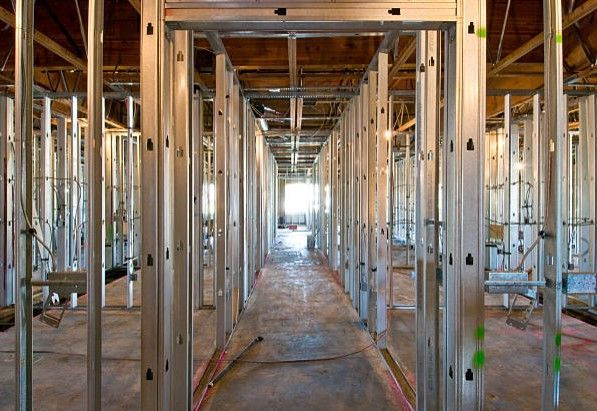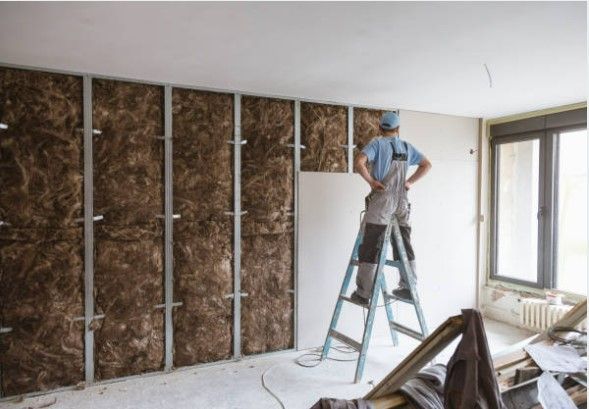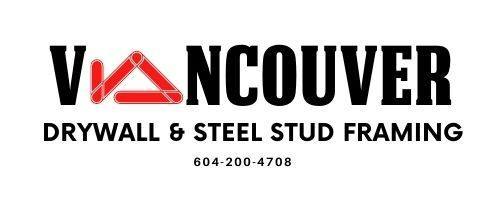Vancouver Steel Stud Framing
How Drywall Steel Studs & Framing Shield Your Property From Fires
Property fires are extremely dangerous and can cause a great deal of damage. A thorough fire prevention strategy raises knowledge and implements preventive steps to avoid fires.
Fire safety procedures reduce injuries and deaths during fire emergencies by preparing people to act quickly. Proper handling of combustible items, electrical safety, and installing high-quality drywall steel studs & framing are all part of fire prevention.

Canada’s Fire Safety Standards and Regulations
The National Fire Code of Canada (NFCC) reduces fire risk and protects persons and property. Last modified in 2020, the Code is updated every five years. The Code includes everything from fire extinguishers to flammable liquid storage. It sets minimum building fire rules, including sprinkler systems and smoke detectors.
The NFCC has extensive fire safety standards for buildings and facilities. It can be adopted or modified by each province and territory. These codes demand building construction and design to improve fire safety.
Steel Stud as Fire Resistance Material
Steel stud framing is used to frame walls, ceilings, and floors. Fire-resistant steel stud framing has many benefits. These factors affect steel stud frame fire resistance:
- Non-flammable material: Steel is non-combustible, which means it does not burn.
- High Melting Point: Structurally sound even at high temperatures.
- Reliable Performance: Remains strong at high temperatures so that engineers can calculate its fire resistance. Predictability improves fire safety assessments during development.
- Lower Fire Load: The heat emitted during combustion is called fire load. Fire containment and damage reduction can improve with a lower fire load.
- Not Mould-Growing: After a fire, water-based firefighting can cause mould. Mould doesn't grow on steel.
- Durability and longevity: Durable steel framing resists deterioration, rot, and pests. Durability can help a structure endure fire and its aftermath.
Wall Framing & Studs: Steel vs. Wood
| Factors to Consider | Steel | Wood |
|---|---|---|
| Fire Resistance | Provide superior fire protection because steel does not burn. | The combustibility of wood studs makes them a potential fire hazard. |
| Strength and Durability | Stronger and more durable than wood. They withstand wood concerns, including warping, rotting, and shrinking. | Wood studs are weaker than. Prone to warping, insect damage, and deterioration. However, quality lumber and careful treatment can increase their durability. |
| Cost | Steel studs and screws might be pricier. However, installation convenience and waste reduction may outweigh the price difference. | Wood studs are less expensive than steel studs when comparing upfront costs. |
| Weight | The lighter weight of steel studs makes them easier to handle and transport. | Transportability and management on the site may be impacted by the heavier weight of wood studs. |
| Installation | Faster and easier than wood. Uniform size, straight, no knots or bowing. | Wood studs are easy to work with, but finding straight and similar pieces may take more effort. The installation process for studs may be longer than steel studs. |
| Environmental Considerations | Eco-friendly because they're recyclable. | Sustainable wood is renewable and eco-friendly. |
| Sound Transmission | Steel transmits sound better than wood, which may increase wall sound transmission. | Wood has natural sound-dampening qualities that may limit the area of sound transmission compared to steel studs. |
| Availability | Generally available; however, regional and store availability may vary. | Available in store for most regions. Can be sold in various sizes and grades. |
Enhance Fire Resistance: Proper Installation Techniques
Improve fire resistance using these tips:
| Process | Details |
|---|---|
| Maintain Proper Stud Spacing | Proper spacing protects the fire-resistant barrier. Install studs plumb and straight to ensure fire-resistant assembly performance. |
| Use Fire-Resistant Insulation | Install fire-resistant insulation between studs to boost assembly fire resistance. Mineral wool insulation is popular for fire resistance. |
| Install Fire-Resistant Sheathing | Use fireproof sheathing, like gypsum or cement board, for framing. Install and secure the sheathing to cover the framing system and create a continuous fire barrier. |
| Seal Penetrations and Joints | Seal framing penetrations, gaps, and joints with fire-resistant caulk or sealants. Be careful around electrical boxes, pipes, and ducts. |
| Consider Fire-Resistant Coatings | Install fire-resistant coatings on steel framing if advised by the manufacturer. These coatings enhance fire protection. |
| Follow Building Codes and Standards | These codes specify materials and construction procedures. |
| Consult with Professionals | Consult a structural engineer or fire-resistant construction experts to meet local rules and project needs. |
| Regular Inspection and Maintenance | Maintain fire-resistant elements with frequent inspections after being installed. Repair damage or deterioration immediately to maintain fire-resistant assembly performance. |
Importance of Routine Inspection
- Fire prevention is the main purpose of routine inspections. Early detection and mitigation of fire dangers can decrease property damage, injuries, and deaths.
- Regular inspections detect fire dangers early. This includes improper wiring, electrical equipment, combustible materials cart storage, and other fire-causing variables in the area.
- Fire safety rules are tight in many places. Routine inspections track facility compliance with these regulations.
- This is necessary for occupant safety and to prevent legal issues and fines.
- Fire extinguishers, sprinkler systems, smoke detectors, and emergency press and lighting must be examined and maintained to work properly. Regular inspections can discover equipment flaws, enabling quick repairs or replacements.
- Many insurers compel businesses and property owners to follow fire safety regulations. Insurers see regular inspections and safety code compliance as risk-reducing factors.
- Routine fire safety inspections allow for continued development. Owners can improve safety, add equipment, and fire emergency readiness by recognizing and fixing deficiencies.

Ensure Fire Safety With Vancouver Drywall & Steel Stud Framing
In terms of fire safety, steel studs and frame systems are the way to go when building a structure. Because of their natural fire resistance, they are a great choice for building fire-safe properties.
Vancouver Drywall & Steel Stud Framing delivers fire resistance, durability, and stability to construction needs. With our expert team of builders, we offer reliable construction with high-quality materials across Vancouver.
Frequently Asked Questions
-
What is the fire rating of steel studs?
The fire rating of steel studs can vary based on their thickness and other factors. Generally, steel studs have a fire rating that ranges from 1 to 3 hours.
-
Are there fire testing standards for steel stud assemblies?
Yes, there are fire testing standards such as ASTM E119 and BS 476 that evaluate the fire resistance of building assemblies, including those using steel studs.
-
How does the orientation of steel studs (vertical vs. horizontal) affect fire resistance?
Fire resistance does not depend on steel stud orientation. The design, including stud spacing, height and arrangement, must meet fire code criteria to achieve the necessary fire resistance rating.

Address
4214 Miller St. Vancouver, BC, V5N 3Z8 Canada
Phone
604-200-4708
vansteelstuds@gmail.com
CONTACT US TODAY!
Contact Us
We will get back to you as soon as possible
Please try again later
